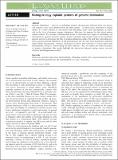Mating ecology explains patterns of genome elimination
Abstract
Genome elimination – whereby an individual discards chromosomes inherited from one parent, and transmits only those inherited from the other parent – is found across thousands of animal species. It is more common in association with inbreeding, under male heterogamety, in males, and in the form of paternal genome elimination. However, the reasons for this broad pattern remain unclear. We develop a mathematical model to determine how degree of inbreeding, sex determination, genomic location, pattern of gene expression and parental origin of the eliminated genome interact to determine the fate of genome-elimination alleles. We find that: inbreeding promotes paternal genome elimination in the heterogametic sex; this may incur population extinction under female heterogamety, owing to eradication of males; and extinction is averted under male heterogamety, owing to countervailing sex-ratio selection. Thus, we explain the observed pattern of genome elimination. Our results highlight the interaction between mating system, sex-ratio selection and intragenomic conflict.
Citation
Gardner , A & Ross , L 2014 , ' Mating ecology explains patterns of genome elimination ' , Ecology Letters , vol. 17 , no. 12 , pp. 1602–1612 . https://doi.org/10.1111/ele.12383
Publication
Ecology Letters
Status
Peer reviewed
ISSN
1461-023XType
Journal article
Description
This research has been supported by a Royal Society University Research Fellowship (AG), a Royal Society Newton International Fellowship (LR) and two NERC Independent Research Fellowships (AG & LR).Collections
Items in the St Andrews Research Repository are protected by copyright, with all rights reserved, unless otherwise indicated.

